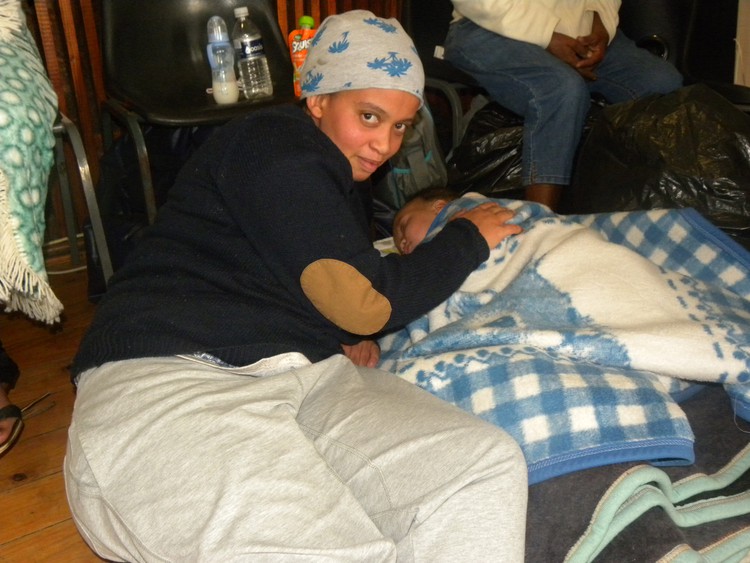Knysna fire victims blame slow response for tragedy
SANParks manager says gale force winds made the situation untenable
Victims of this week’s fire in the Southern Cape that left nine people dead claim that South African National Parks (SANParks) ignored their calls to douse the fire before it spread out of control.
The devastating fire claimed the lives of eight people in Farleigh, near Karatara, which is a town in the Knynsa Municipality. It also claimed the life of Knysna firefighting pilot, Nico Heyns, 65, who died after his helicopter crashed while fighting the fire.
Karatara and the surrounding areas consist of a mixture of municipal and SANParks staff settlements.
About 1,200 people were evacuated in the Karatara and Rheenendal area near Knysna. Most of the people were given temporary shelter in community halls. One hundred people were housed at a community hall in Sedgefield, just outside Knysna.
Fire victims who sought refuge in the Sedgefield community hall told GroundUp on Wednesday they had informed SANParks on Sunday after noticing a fire in the mountains around Karatara. They said they were concerned because they had heard about the devastating fire in George.
Irvin Draai, 48, stays in Karatara with his wife and two children. He said he was upset by the way the municipality and SANParks reacted to their plight.
“We saw the fire on Sunday in the mountains around Karatara and we immediately notified SANParks who surprisingly told us that the fire was too small to reach our houses. This despite there being terrible winds. The fire was also already causing havoc in the George area,” said Draai.
“On Monday the smoke reached our homes. The whole area was then enveloped in smoke. Our efforts to contact the municipality were also unsuccessful and their fire brigade was not reachable. Eventually people packed light valuables like identity books and bank cards and then we walked on foot towards Sedgefield.”
Draai said assistance only came in the form of a taxi that stopped to offer them a lift to Sedgefield town.
“We felt dumped by the municipality and SANParks … we had to struggle helping the elderly and children,” said Draai. “It was like a nightmare for most of us because children were crying hysterically from thirst. They were also inhaling smoke from the burning fire.”
Hazeldene Hartzenberg, 25, from Karatara said she had to use her hands to ward off thick plumes of smoke to prevent her seven-month-old baby from suffocating.
“Our house’s windows were shattered by the fire and the roofing damaged by the smoke. I don’t know how we are going to repair it,” said Hartzenberg. “I had to strap my child to my back and run away leaving most of my belongings behind. SANParks owes us an apology. They should have assisted us because there were young children and the elderly who struggled to run away on foot.”
Garden Route National Park manager Paddy Gordon said SANParks were part of a joint fire combatting operation.
Gordon said, “The fires in the catchment area above Karatara were being addressed by the joint operations. On Sunday this fire in the catchment area posed no risk to any community in the area. However, on the morning of Monday 29 October, there appeared to be a slow movement of the fire towards the south … the decision was taken on Monday morning to create another fire break … to reduce the fire risk from spreading south.”
He said at that stage there “was no indication of risk to Farleigh or Karatara” and that the fire break had been “carried out successfully … and according to fire management standards”.
“What happened after this was not possible to predict,” said Gordon. “Gale force winds picked up and gusted to speeds in excess of 100 km/h. This caused the very large George fire to merge with the fire in the Karatara catchment area. The increased intensity of this fire caused sparks to be blown for several kilometres over long stretches of indigenous forest which acts as a natural fire break.”
Gordon said the dense smog caused by the combined fires made visibility too low for any aerial attack on the fires. “The gusts of winds sped the fire through the Farleigh-Karatara area at a rate that no fire resources could combat.”
Samuel de Waal, 34, is a former firefighter from Karatara and once worked for SANParks. He left two years ago. De Waal said there were no longer fire guards along the boundary of houses to prevent fire from encroaching.
“Things have just changed in the last two years. SANParks [has] stopped erecting fire guards around houses. They have even stopped cutting grass around the sides of the roads to avoid fire from spreading,” said De Waal.
“This is the second disaster after the one that happened last year. SANParks should have learnt from that experience how to prevent such outbreaks. It is very painful that lives were lost that could have been prevented had better measures been taken,” said De Waal.
Next: When the president appointed a panel without women
Previous: Rwandan man faces death if he is deported from South Africa
© 2018 GroundUp.
This article is licensed under a Creative Commons Attribution-NoDerivatives 4.0 International License.
You may republish this article, so long as you credit the authors and GroundUp, and do not change the text. Please include a link back to the original article.



